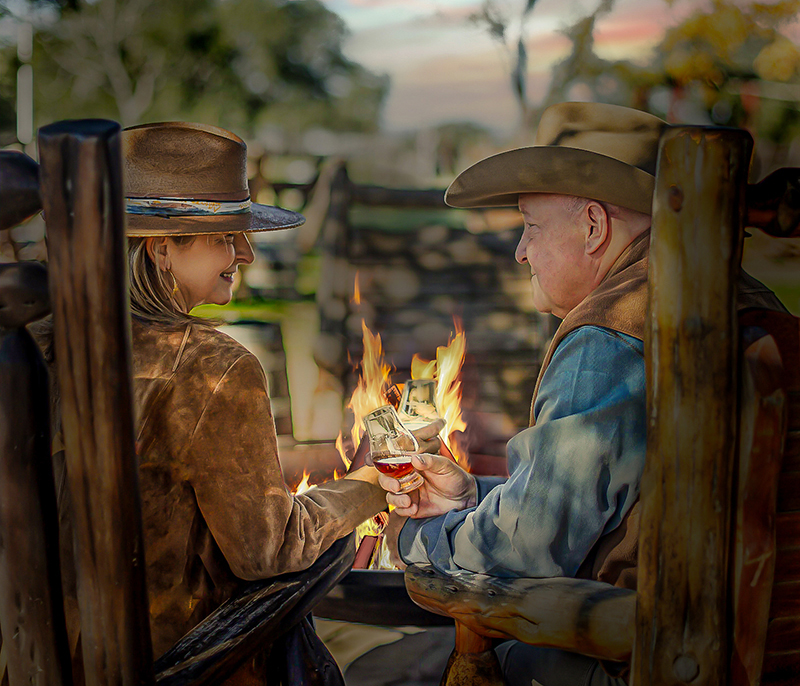On a quiet road in Hye, the Garrison Brothers Distillery sits amid a sea of rolling hills and verdant pastures. Unbeknownst to many, the company is the first legal whiskey distillery in the state of Texas, not to mention the first outside of Kentucky to make handmade bourbon whiskey. At its core, founder Dan Garrison and his team believe that “good bourbon can change the world,” so much so that the motto was muraled on a 27,000-square-foot barn on their 68-acre property.
For Garrison, the motto is deeply personal too. Though his love of bourbon has been lifelong, owning a spirit’s business wasn’t in The University of Texas graduate’s original plan. Over twenty years ago, he was working in the advertising industry when he found himself caught in the crosshairs of the Enron scandal. Ultimately, the setback spurred him to step into a new chapter of self-reinvention. “I knew I wanted to do something for myself by myself,” he remembers. “There were only nine distilleries in America making bourbon [at that time] and they were all based in Kentucky, so I went up there and figured it out.”
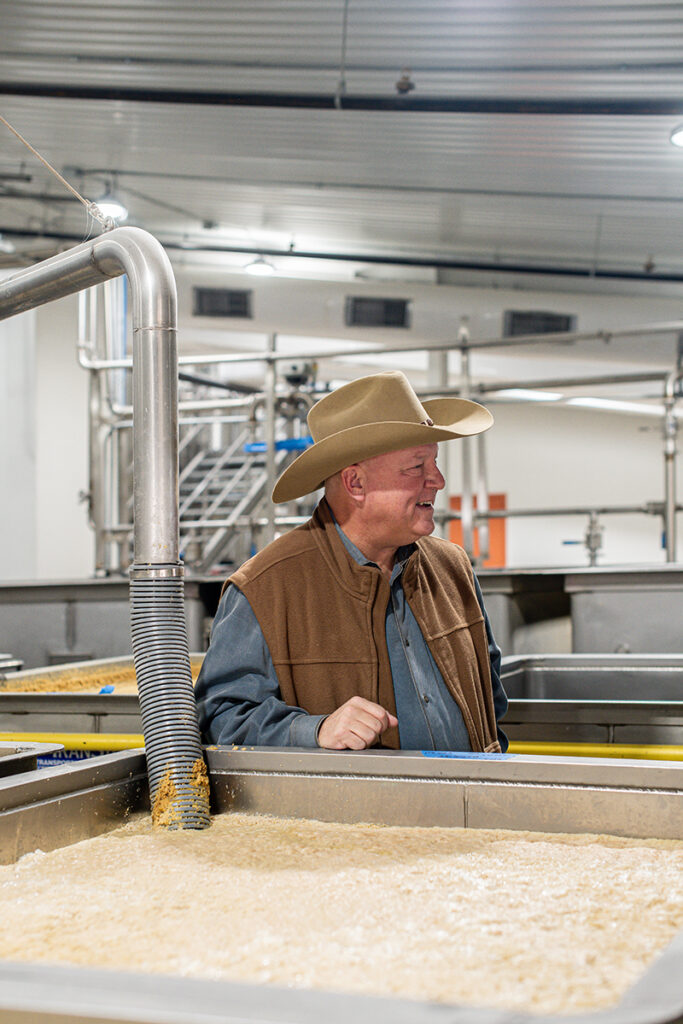
Garrison still remembers his initial visit to the Bluegrass State, and the looks of dismay and doubt he received along the way. “Everybody thought I was crazy when I showed up with my cowboy hat on and said I was going to make bourbon in Texas,” he remarks. Bourbon and whiskey may have been the libation of choice in the pre-Prohibition and post-World War Two eras, but they’d experienced a marked decline in popularity up until the turn of the 21st century. Still, as a lifelong bourbon drinker, Garrison and his wife, Nancy, decided to take a risk. “I had this weird feeling that it was going to come around,” he says adding, “and sure enough, it did.”
Since its founding in 2006, Garrison Brothers has grown nationwide, with its products now available in all fifty states. Visitors passing through the Hill Country can drop in for tours of the facility, which includes a lively, open-air hayride with stops along the way. For many, meeting the Garrison Brothers’ mascot, Ferdinand, is a highlight of the tour. The Montana-based artist, Sean Guerrero, sculptured the studly steer from salvaged metal automobile parts.
Just beyond Ferdinand is The Cook House, where the production process begins. Inside, the warm and heady smell of cooked corn, soft red winter wheat, and two row barley floats over the room. “It is a living, breathing organism,” Garrison says of their sweet golden mash, which bubbles from within large tanks.
Before it becomes mash, however, the process starts with basic raw ingredients. Three large silos hold tens of thousands of pounds of corn, wheat, and barley, all of which is ground to a fine, flour-like consistency. Once weighed and measured, the pulverized grain is cooked and cooled using a system of boilers and coolers. A 30,000 BTU boiler system operates the intricate cooking process while the introduction of 40-degree water, sourced from wells and rainwater captured onsite, brings the temperatures down. Next, the mixture is transferred to tanks and incorporated with yeast to ferment for five days. “It smells good, doesn’t it?” Garrison remarks as he walks through the room. “It is just like making bread.”
After fermentation, the mixture – which is called distiller’s beer at this stage – is pumped to The Still House, where the alcohol is distilled out. Inside, Garrison and his longtime colleague and master distiller, Donnis Todd, move like alchemists around the laboratory of copper stills and columns, hydrometers, and condensers. Garrison’s first and original still, a one-hundred-fifty-year-old unit called the Copper Cowgirl, is a source of pride for the entrepreneur, and the keeper of many stories. “She was Elmer T. Lee’s still that he used at Buffalo Trace to create Blanton’s Bourbon, but even before that she worked at Wild Turkey, so she’s steeped in bourbon history,” he says. Neighboring the Copper Cowgirl are stills called Fat Man, Little Boy, and the Big Johnson, the latter of which is named for the late President who grew up close by. After distillation, the bourbon, or “white dog” as it’s called before being transferred to the barrel, is aged in American White Oak.
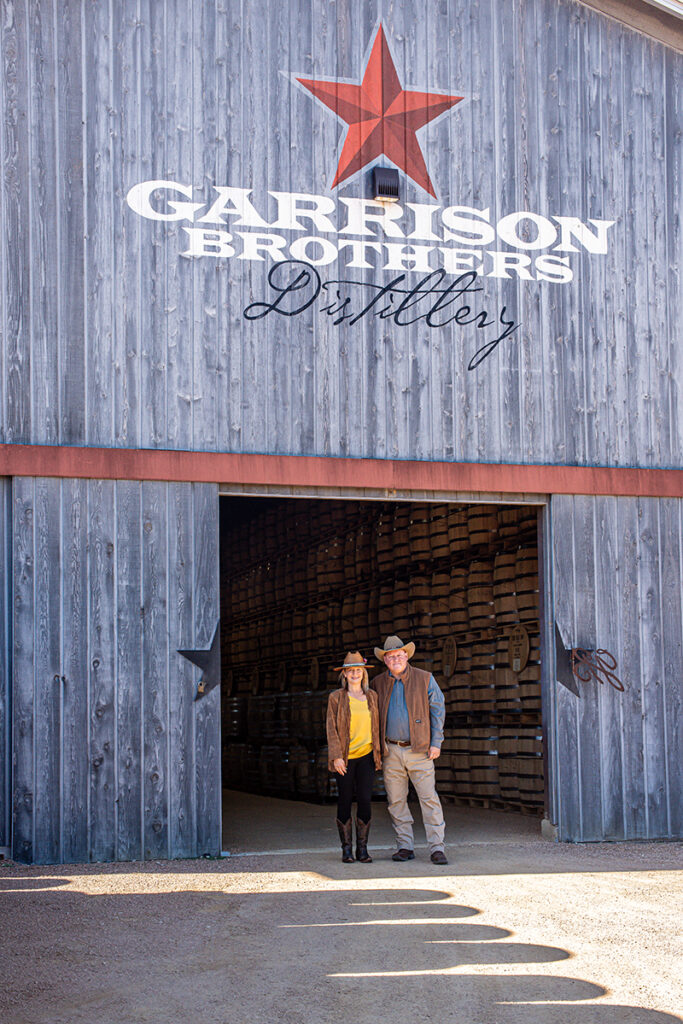
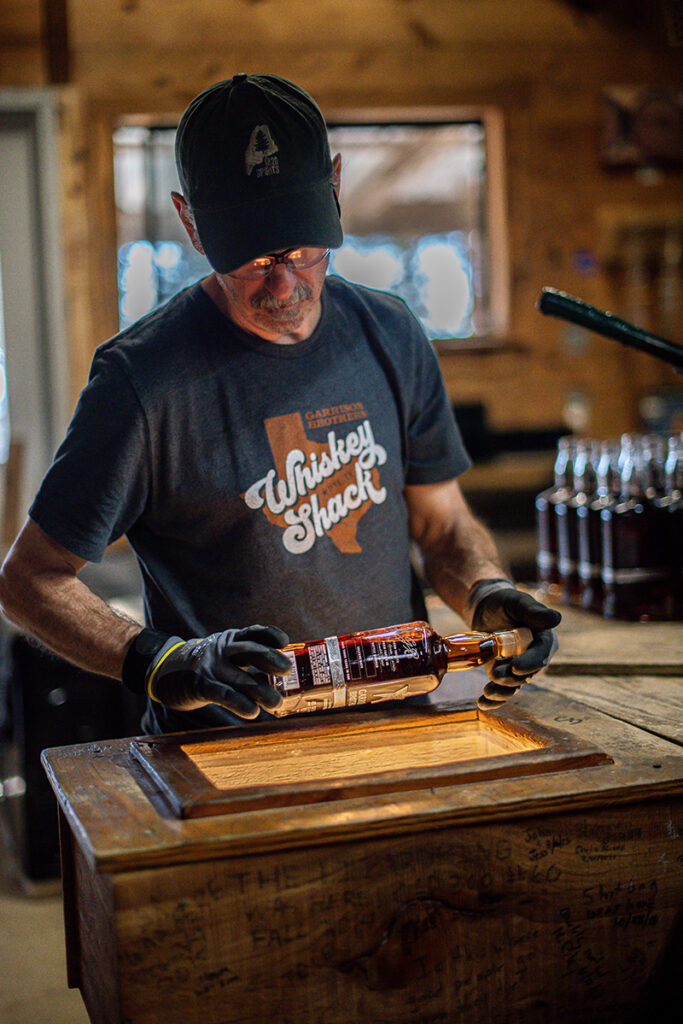
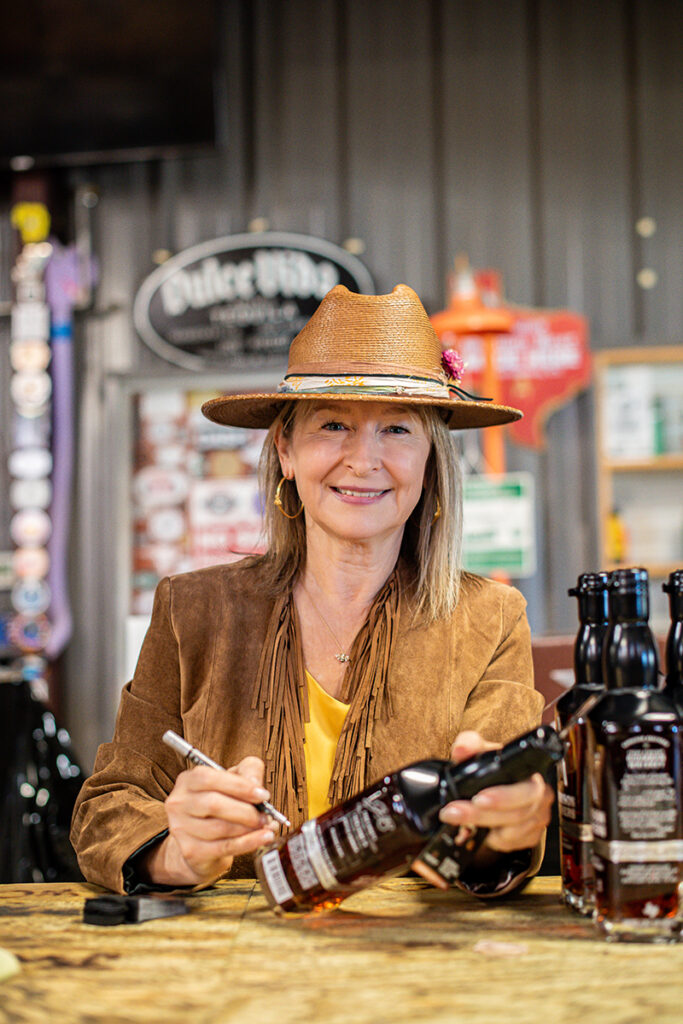
From corn to cork, Garrison Brothers’ bourbon is made with love, one barrel at a time. Today, the company is producing over one-hundred-and-sixty 53-gallon barrels at the distillery every week. Each step of the process is laden with tradition, and bottling is no exception. Every morning, volunteers from the Hill Country and further afield line up to work in Garrison’s bottling room, and their names and messages are scrawled on the walls as a memento of those visits. Between filling, inspecting, cleaning, packaging, and preparing the bottles for distribution, Garrison says it’s the convivial spirit and close-knit community that he loves most about the bourbon industry.
“All the people here are becoming friends, and that’s what happens when you drink bourbon and whiskey,” he shares. “It creates strong relationships, faith in God and man, and legendary stories. It is a magical spirit, a craft, an art, and a big family.” The founder takes pride in caring for his extended family, including the volunteers who find him, saying, “We give them breakfast in the morning, lunch in the afternoon, and a shot of courage to keep them motivated throughout the day.” Lunch and libations are served in a barn nearby, where each of the brand’s bourbon whiskeys are lined up in a row.
Behind the long bar, Garrison invites patrons to saddle up and sample his breadth of bourbons, all of which are served in tulip shaped Glencairn crystal glasses from Scotland. His wife, Nancy, was the brainchild behind two of their popular varietals, including the HoneyDew and the Lady Bird. The former is aged in new, charred American white oak casks and infused with Texas-grown wildflower honey. Others, like the Guadalupe, were finished in port casks imported from Portugal, giving the bourbon a sensuous and creamy profile. Sixty percent of their business is attributed to their best-selling Small Batch Bourbon, an amber-crimson elixir with a long, smooth finish. No matter what patrons drink, however, Garrison urges guests to imbibe slowly and savor the experience. “Everybody is used to chugging stuff and that’s just not what we do here,” he shares. “When you drink bourbon, treat it like an M&M, let it roll around for a few seconds and melt onto your tongue, that takes the burn away.”
One of the key traits that helps Garrison stand apart from other bourbon aficionados is his encyclopedic knowledge of wood. “That’s kind of what I pride myself on,” he explains. “When I first met Jimmy Russell, the master distiller at Wild Turkey, he talked about how eighty percent of bourbon’s flavor comes from the barrel and twenty percent comes from the white dog. It doesn’t get its sweetness until it goes into a barrel.” Knowing this, Garrison made it his mission to study different barrel types and understand how each one would contribute to the bourbon’s flavor profile. Today, he uses four distinct cooperages at Garrison Brothers, and finishes his products in roughly a dozen variations of oak wood.
Now, as his team continues to expand and experiment with new product offerings, the brand is also developing new infrastructure. The distillery in Hye has recently undergone a sizable expansion project that includes the addition of eight 4,000-gallon fermentation tanks, and a state-of-the-art showcase barn designed by Juan Miró of Miró Rivera Architects in Austin. Ahead of its grand opening next spring, Garrison and his team have plans to plant one hundred trees around the distillery, where they will host special events throughout the year. In addition to the bar and stage outside, the barn also has an expansive, culinary-grade kitchen, and a 21,000-square-foot storage space where they can house over 14,000, 53-gallon barrels.
During the pandemic, the entrepreneur even added a new food and beverage concept called The Garrison Brothers Whiskey Shack. Visitors are invited to break bread over lunch or dinner at the venue, where the seasonal menu includes everything from savory sandwiches to street tacos, mezze boards, and homemade biscuits made using the distillery’s sweet mash. Others come to sit and relax over a smooth bourbon cocktail, like a classic Old Fashioned or a Frozen John Daly.
Reflecting over their growth and resilience in recent years, Garrison is quick to credit his wife and team of roughly one hundred employees for their success thus far, along with their legion of loyal fans. Chief among the latter is a group called The Old Three Hundred. These are the people who believed in Garrison from the start. “They are our dignitaries and our biggest fans,” he says of the multi-faceted group. “They really care about our business and do amazing things for us, including opening up doors to bars and restaurants, so we love them and take care of them.” Members of The Old Three Hundred are invited to two exclusive events per year, including a spring carnival and a bourbon camp in the fall, and they also receive early access to special releases.
Giving back to loyal patrons is only part of Garrison’s mission. These days, the family pays it forward through their non-profit, Good Bourbon for a Good Cause. “We are working hard to integrate a spirit of giving back with our staff,” he says. Given the number of veterans who work and volunteer at Garrison Brothers Distillery, many of the organizations they collaborate with revolve around veteran’s support. Most recently, they’ve contributed to Candlelight Ranch and Patriots’ Hall, the latter of which is a healing retreat and resource base for veterans and their families.
At the distillery’s entrance, an American flag flies reverently over the fence line as cars turn into the property. It’s been eighteen years now since Garrison first chased after his dream, officially founding the first legal whiskey distillery in the state. “People were making whiskey all over America after prohibition, so we can’t say we were actually the first whiskey distillery in Texas,” he admits, “but we were the first legal whiskey distillery because we went through the process of getting a permit from the federal government and from the state, and that permit allowed us to make legal whiskey here.”
The fact that this trailblazing spirit is made deep in the heart of the Texas Hill Country, speaks volumes about Garrison’s entrepreneurial grit and unwavering dedication. “After nearly twenty years of doing business, we are right on the verge of profitability, and I know this is going to work,” he says, smiling. “We think we are going to be around for a while.”


